Joe Blevins's Blog, page 38
November 8, 2022
Podcast Tuesday: "The Big Chill"
 Vahan Moosekian on Happy Days.
Vahan Moosekian on Happy Days.It was inevitable. We reviewed an episode of Happy Days I loved ( "Just a Piccalo" ), then an episode I hated ( "No, Thank You" ). The logical next step was an episode I was totally indifferent to. And that's what "Baby, It's Cold Inside" is. It's the most basic, stock sitcom episode you can imagine. The damned thing might as well have been assembled from a kit. This didn't need even need to be a Happy Days episode especially; just about any family sitcom could have done this story.
The plot has Joanie (Erin Moran) taking care of her infant nephew, Richie, Jr., while her parents (Tom Bosley and Marion Ross) are out of town. She wants to prove to her folks that she's a responsible young woman, not just a little kid. Naturally, there are complications. The boiler breaks down during a cold snap, and a wisecracking repairman who calls himself Rudy to the Rescue (Vahan Moosekian) wants $200 to fix it. Also, Richie, Jr. is suffering from his first-ever cold. To make things worse, Joanie's friend Jenny (Cathy Silvers) has invited all their idiot friends over to the house for an impromptu party. How will Joanie handle all these disasters at once? The answer turns out to be not that interesting, quite frankly.
Can we turn a dull episode into an exciting podcast? Find out by listening to the latest installment of These Days Are Ours: A Happy Days Podcast . If nothing else, if you stick around until the end, you'll hear some music by the one and only Weird Paul . Thanks, WP, for letting us use your song!
Published on November 08, 2022 07:49
November 2, 2022
Ed Wood Wednesdays: The Ed Wood Summit Podcast #28 by Greg Dziawer
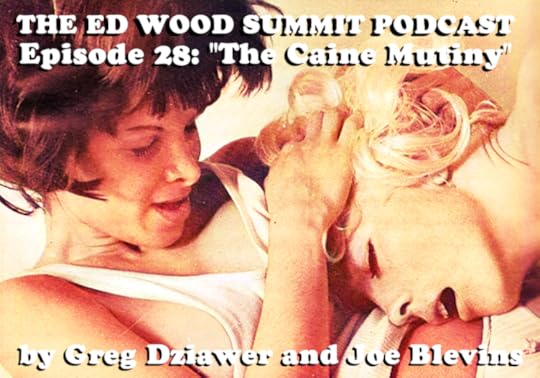 Two ladies enjoy each other's company in Caine Richmond's "Les Pad."
Two ladies enjoy each other's company in Caine Richmond's "Les Pad."Dick Trent and Ann Gora are names known to any true Ed Wood superfan, since Eddie wrote books, articles, and scripts under these monikers for years, but have we discovered yet another of his many professional pseudonyms?
The sheer volume of texts written by Edward D. Wood, Jr. in the 1960s and '70s is unquestionably, well, voluminous. At some point in the early 1960s, Ed began writing for the adult entertainment industry—paperbacks and screenplays at first, followed by magazine articles and 8mm porno loops. By the end of the decade, he was writing all of these and then some, often concurrently!
In the midst of this writing frenzy, an obscure adult publishing company called Bernel and Associates—likely a predecessor to the Pendulum/Calga powerhouse that employed Eddie for years—briefly published a small number of adult mags. No one knows for sure how many, but one was Tailgate from 1968, which seemingly ran for just one issue. In that lone edition, there are three texts. One of them, an article called "Sappho" credited to Caine Richmond, appeared here last year. I suggested, gently, that it might be the work of Edward D.Wood, Jr.
But "Sappho" was not the only text in that issue credited to the mysterious Caine Richmond. The other was an intriguing short story called "Les Pad." This week on The Ed Wood Summit Podcast, Joe Blevins joined me to break it down, and we implicitly asked the question: could it, too, have been written by Ed Wood?
All episodes of The Ed Wood Summit Podcast can be found here .
Further reading: A review of Ed Wood's novel Nighttime Lez (1968) A review of Ed's article "Sappho Revisited" (1973)
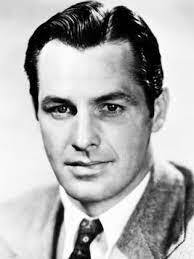 Kane RichmondP.S. Reader Bill Shute has some additional insight into the "Caine Richmond" pseudonym:
Kane RichmondP.S. Reader Bill Shute has some additional insight into the "Caine Richmond" pseudonym:
Using the name of one of the greats of serials and b-movies, Kane Richmond, spelled creatively, is certainly something Ed Wood would have done.... proudly. This is a man who was excited to get old genre-film pros such as Reed Howes (who he wrote about admiringly in Hollywood Rat Race) and Herbert Rawlinson in his films. Had Kane Richmond still been working in films in the 1950s (he retired from the screen and went into the business world circa 1948-49), there's no question that EW would have tried to get him for a film and would have loved chatting with him about his serials and low-budget action films. It always puts a smile on my face when Ed Wood champions an old-time Hollywood figure, someone who was largely forgotten by the industry.
Thanks for the added info, Bill!
Published on November 02, 2022 16:46
November 1, 2022
Podcast Tuesday: "Jumping the Nun"
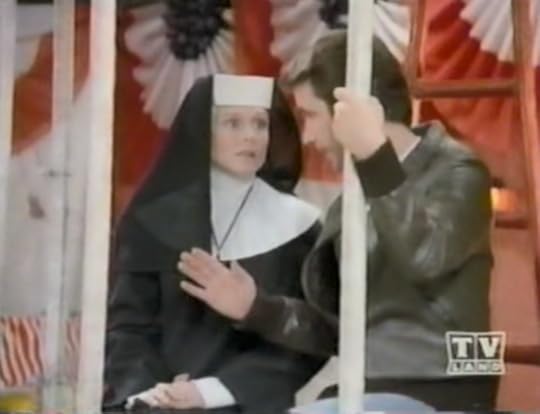 Diane Adair (aka Diane Diefendorf) and Henry Winkler on Happy Days.
Diane Adair (aka Diane Diefendorf) and Henry Winkler on Happy Days.Nuns were weirdly popular in the 1960s. Cheerful, fun-loving nuns, that is. (Dour, punishment-inflicting nuns apparently had the decade off.) One of the biggest films of the era was The Sound of Music (1965), the tuneful story of a manic pixie dream nun, Maria (Julie Andrews), who leaves her convent to work for a stern, widowed Austrian baron (Christopher Plummer) as a nanny to his seven rambunctious children. In short order, with some help from a score by Rogers & Hammerstein, Maria wins over the children and then their father, teaching them how to enjoy both life and music.
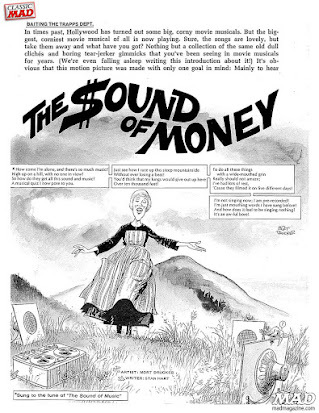 "The $ound of Money" (MAD, 1967)
"The $ound of Money" (MAD, 1967)And this was just one example of the nunsploitation trend! On TV, there was Sally Field in The Flying Nun (1967-70), a gimmicky sitcom about a petite nun whose habit allows her to become airborne for short periods of time. And on the pop charts, there was "Dominique," a French-language novelty song by Sœur Sourire aka The Singing Nun. With its catchy melody, it became a widely-loved #1 smash hit in 1963, but the authors of The Encyclopedia of Bad Taste (1990) maintain that "Dominique" forever robbed nuns of their dignity and mystique. They write of the song: "It was a pop music phenomenon, and it toppled nuns from their pedestal. Suddenly the world was faced with an epidemic of kooky, perky, goofy nunnish antics."
MAD tackled this very phenomenon when they parodied The Sound of Music as "The $ound of Money" in 1967 with art by Mort Drucker and a script by Stan Hart. That marvelous satire includes spoofs of many of the songs from the film, including "How Do You Solve a Problem Like Maria?" MAD's version was called "How Do You Solve the Problem of Religion?" and it went (in part) like this:
The ninth season of Happy Days takes place in 1963, the year of "Dominique," so it's only natural that they'd have their own take on the nunsploitation genre. Their version was called "No, Thank You" or "The Nun's Story." The plot has a young nun named Gloria (Diane Adair) teaching history at Jefferson High. Not knowing his new colleague is a bride of Christ, Fonzie (Henry Winkler) pursues her romantically (without success) and even forces a kiss on her. Naturally, when he learns the truth, Fonzie is eaten up with guilt. But Gloria is one of those happy-go-lucky, non-judgmental '60s pop culture nuns, so she's not mad at all. The episode ends with Gloria knocking Fonzie into the water at a carnival dunk tank, a scene that reminded me very much of the MAD song about "the problem of religion."
How do you solve the problem of religion? How do you handle nuns and not offend? Just simply have them doing things they wouldn't! Don't follow the norm, Or stay true to form. Pretend!
Just show a kooky nun who rides a scooter. Or show a Sister try to fly a kite. The movies can make folks feel That all these events are real, And being a nun is fun from morn 'til night! People will eat up films about religion! Just keep them corny, saccharin and trite!
But how is the episode overall? Find out by listening to the latest installment of These Days Are Ours: A Happy Days Podcast .
Published on November 01, 2022 05:06
October 25, 2022
Podcast Tuesday: "A Simple Desultory Phil Silvers (or How I Was Sgt. Bilko'd into Submission)"
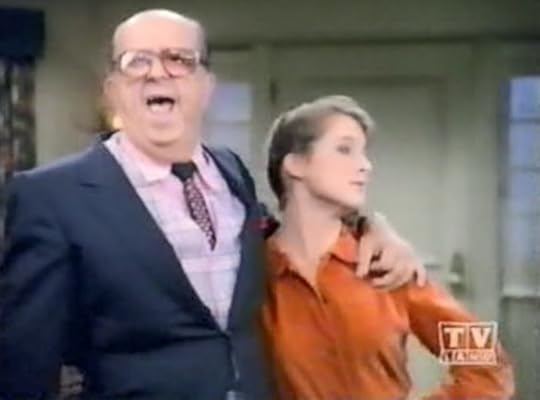 Phil Silvers and Cathy Silvers on Happy Days.
Phil Silvers and Cathy Silvers on Happy Days.After Ron Howard and Don Most left Happy Days in 1980, taking the characters of Richie Cunningham and Ralph Malph respectively with them, the producers brought in some replacements to round out the cast, namely Ted McGinley as Roger Phillips and Cathy Silvers as Jenny Piccalo. Roger, a straight-laced, preppie basketball coach, was an obvious substitute for the very square Richie Cunningham. But does that mean gossipy, boy-crazy Jenny Piccalo was somehow the new Ralph Malph?
At first, these characters would not seem to have much in common. Were they to meet, the conversation would probably be a little awkward. But, upon closer inspection, I can see how Jenny Piccalo became the show's new Ralph Malph during its final seasons. After all, Ralph is the wacky, wisecracking sidekick to the more responsible, pragmatic Richie, just as Jenny is the wacky, wisecracking sidekick to the more responsible, pragmatic Joanie (Erin Moran).
It's important to remember here that Joanie's personality changed subtly over the course of nine seasons. She started out as the somewhat bratty, insult-slinging kid sister whose main job was to keep Richie's ego (and those of his idiot friends) in check. She was even the first character to utter the show's immortal catchphrase, "Sit on it!" But as the sitcom wore on, Joanie matured, toned down her personality, and even settled into a long-term relationship with Chachi (Scott Baio). She was in danger of losing her edge, but the wilder Jenny Piccalo was able to tempt her into various hijinks and shenanigans, just as Ralph once did with Richie.
Jenny's relationship with her father Roscoe (played by Cathy's real-life father, Phil) is even similar to Ralph's relationship with his father Mickey (Jack Dodson). In the Season 4 episode "Last of the Big Time Malphs," Ralph runs up a gambling debt but can't talk seriously about the problem with Mickey because the latter is such a zany jokester. Jenny runs into a similar problem during "Just a Piccalo," the Season 9 episode we're reviewing this week on These Days Are Ours: A Happy Days Podcast . She's facing vandalism charges after trying to steal a statue from the park, but she doesn't feel she can go to Roscoe for help. How interesting that both Mickey and Roscoe are played by classic sitcom stars: Jack Dodson from The Andy Griffith Show and Phil Silvers from Sgt. Bilko.
I hope you'll join us for our review of "Just a Piccalo." As usual, this episode let us talk about a whole bunch of topics, including the brilliant career of Phil Silvers. This one was a real treat to record.
Published on October 25, 2022 15:11
October 18, 2022
Podcast Tuesday: "Let's Talk About Talking About Sex"
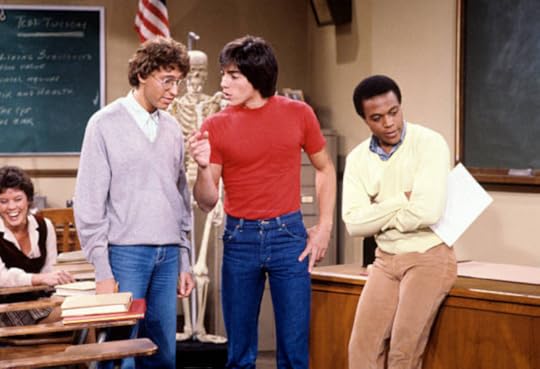 (left to right) Erin Moran, Scott Mitchell Bernstein, Scott Baio, and Kevin Rodney Sullivan on Happy Days.
(left to right) Erin Moran, Scott Mitchell Bernstein, Scott Baio, and Kevin Rodney Sullivan on Happy Days.Sex education. Even the phrase makes me cringe a little. I remember, back in fifth grade, we had to get a special permission slip signed by our parents before we could take our school's one-day sex ed course. I was too mortified to give my parents such a permission slip, so I just skipped school that day. I can't remember where I hid out (probably home), but I got mercilessly clowned on by my classmates when I returned to school the next day. And they were right: I was a total wuss. So, a year later, I actually got my parents to sign the permission when it was time for our sixth grade refresher course. I remember almost nothing of what we were actually taught that day.
Since it's a sitcom about hormone-crazed teenagers in high school, Happy Days was eventually going to do a sex ed episode of some kind. It was inevitable. Nevertheless, the writers held out until Season 9's "Fonzie the Substitute" aka "Give Me Puberty or Give Me Death." The plot? Fonzie (Henry Winkler) fills in for Roger (Ted McGinley) during the latter's high school health class. The sneaky students trick Fonz into giving an impromptu lesson about puberty, which gets Roger in hot water with the board of education.
This counts as one of Happy Days' many "very special episodes" since it's about the importance of teaching kids the facts of life, and the topic is handled respectfully. Maybe too respectfully. The actual topic of sex is never discussed in any detail onscreen. The only biological fact we get from "Fonzie the Substitute" is that you can't get pregnant by making out while wearing a bathing suit.
Other than that, how is the episode? Find out by listening to the latest installment of These Days Are Ours: A Happy Days Podcast .
Published on October 18, 2022 14:54
October 12, 2022
Ed Wood Wednesdays: The Wood Nympho Odyssey by Greg Dziawer
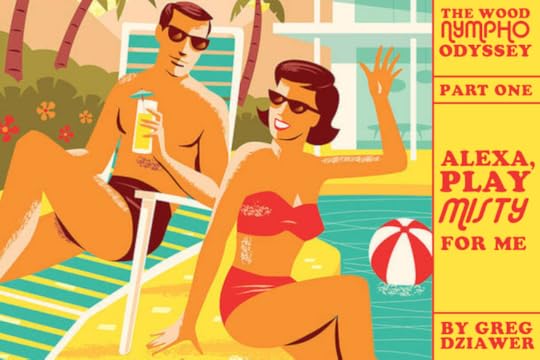 This week, Greg shows us how to have fun on the beach.
This week, Greg shows us how to have fun on the beach.As time wears on, mysterious or once-thought-lost film works involving Ed Wood continue to turn up. The 1971 erotic biker film Misty aka Nympho Cycler is a good example. Before it appeared on disc roughly a decade ago, this obscure movie was completely unknown under the latter title and barely known under the former. In Rudolph Grey's 1992 book Nightmare of Ecstasy: The Life and Art of Edward D. Wood, Jr., it's listed in the "Chronology" section as an "uncompleted" film. The only quote about the film in the main body of the book comes from filmmaker Joe Robertson: "In Misty, [Ed Wood] was in a jacuzzi and all dragged out."
The film's profile stared rising with a DVD release in 2014, which Joe Blevins reviewed here . Back then, he noted that the film had turned up previously on tape in the UK in the early '80s from Dapon , the same company that released The Young Marrieds on tape at the time.
While there's been speculation that the film was directed by Joe Robertson, Casey Larrain told me last year that she recollects Ed Wood himself directing it. For what it's worth, the IMDb page for the film now agrees. Casey also recalled a scene shot at Venice Beach, with Ed directing. He had gathered a group of homeless men for the shoot. "He brought a bottle of jug wine, and we sat in a circle passing it around. Joints were being passed around. Actual marijuana!" She was certainly recollecting the the nighttime beach orgy scene from Nympho Cycler.
Published on October 12, 2022 16:43
October 11, 2022
Podcast Tuesday: "In Which Fonzie Cucks Roger"
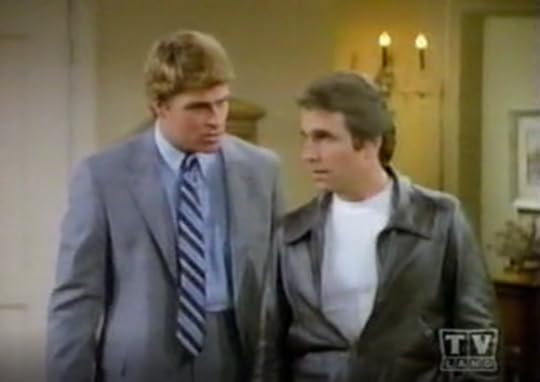 Ted McGinley and Henry Winkler on Happy Days.
Ted McGinley and Henry Winkler on Happy Days.As tough as it is to believe, our humble Happy Days podcast just turned four years old this month. Yes, the first episode of These Days Are Ours dropped on October 2, 2018. What a different world it was back then. We hadn't even heard the word "Covid," and England still had a queen. Gosh, we were all so innocent. I genuinely hope TDAO has improved over the course of those four years, both technically and content-wise. Our show is extremely low-tech and low-budget, but I want it to be listenable and enjoyable nevertheless.
Even after 190 episodes, I still screw up majorly sometimes. Take this week's podcast, a review of the Season 9 Happy Days episode "The Other Guy." During the recording, I must have been hitting the microphone cord or something, because there were a lot of clicks and clacks on my end. I did my best to edit around them. Several minutes of audio simply had to be thrown out. A few lines had to be rerecorded completely. In short, this episode was an editing nightmare. It might have been easier to junk the episode entirely and start over from scratch, but I managed to piece together a show from what I had.
How did it turn out? Well, just listen and find out for yourself.
Published on October 11, 2022 15:08
October 4, 2022
Podcast Tuesday: "Fonzie Has Richie's Baby"
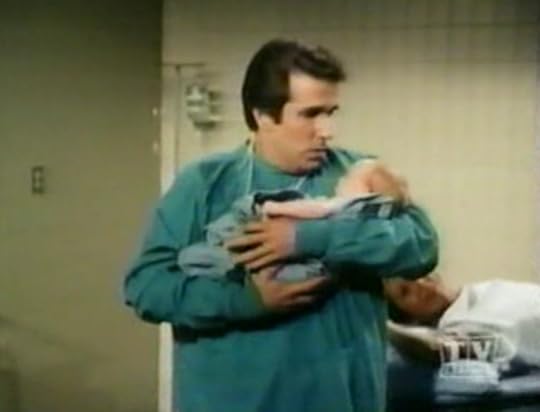 Henry Winkler, an unnamed baby, and Lynda Goodfriend on Happy Days.
Henry Winkler, an unnamed baby, and Lynda Goodfriend on Happy Days.Some people just have to be the center of attention all the time, no matter the circumstances. You know the type—the bride at every funeral and the corpse at every wedding. On Happy Days, Milwaukee mechanic Arthur "Fonzie" Fonzarelli (Henry Winkler) is such a person. A shameless showboat, he thrives on attention and withers without it. He has to make everything about himself.
The Season 9 episode "Little Baby Cunningham" is a perfect example. The plot has Lori Beth (Lynda Goodfriend), wife of Fonzie's best friend Richie Cunningham (Ron Howard), giving birth to her first child. Since Richie is stationed in Greenland with the Army, however, Fonzie takes Richie's place, both in natural childbirth classes and in the delivery room. When Richie, Jr. is born, Fonzie is even the first to hold him! Through all these events, Fonzie carries on melodramatically, stealing focus from Lori Beth, who should be at the center of this story.
If all this sounds a little familiar, it's because Happy Days basically did the same thing in "R.C. and L.B. Forever," in which Fonzie stands in for Richie at the latter's wedding. Ron Howard left the show in 1980 after seven seasons, allowing costar Henry Winkler to take over the show completely. Well, except for Chachi (Scott Baio). Anyway, "Little Baby Cunningham" is very much a sequel to "R.C. and L.B. Forever." Once again, Fonzie replaces Richie during a major life milestone and hams it up shamelessly the entire time.
Does this make for a good episode or a bad one? Find out when we review "Little Baby Cunningham" on These Days Are Ours: A Happy Days Podcast .
Published on October 04, 2022 14:48
September 28, 2022
Ed Wood Wednesdays: The Wood Loop Odyssey, part 27 by Greg Dziawer
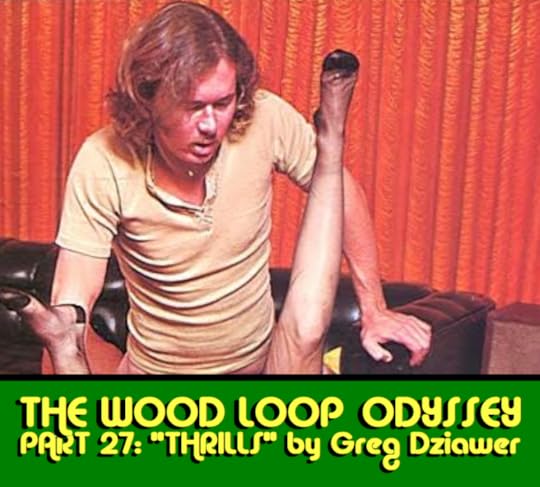 A lad and lass get to know each other in Nightclub Rendezvous.
A lad and lass get to know each other in Nightclub Rendezvous.Just prior to the launch of the Swedish Erotica loops in the early 1970s, adult movie honcho Noel Bloom produced a number of X-rated loops under the Danish International Films imprint. These short erotic films were among the first of their kind to be subtitled. This is significant, since I believe that Edward D. Wood, Jr. penned some or all of these subtitles and provided similar services for other loop series.
Although Swedish Erotica would ultimately become his company's primary loop series, Noel Bloom continued to push the Danish angle throughout the decade. In 1975, just a few years after Danish International Films, Bloom et al. launched the Danish Films series. An early title in this franchise, Nightclub Rendezvous, was not only subtitled, but was also featured in issue two of Danish Films magazine. (There seems to have only been two issues of this publication.) The Danish films loops are strikingly similar to the Swedish Erotica loops—running concurrently and seemingly made by the same creative principles.
Interestingly, Nightclub Rendezvous—labeled #1006 and designated the sixth entry in the Danish Films franchise—opens with the same "logo" as some of the earlier Danish International Films: a young lady licking a large swirled lollipop as she enticingly looks back over her shoulder at us.
From the text in the magazine, we learn that the male and female protagonists are named Larry and Billie. In the loop itself, the only other character, a bartender, is referred to as Duffy .
Published on September 28, 2022 14:40
September 27, 2022
Podcast Tuesday: "Just Break Up Already, You Two"
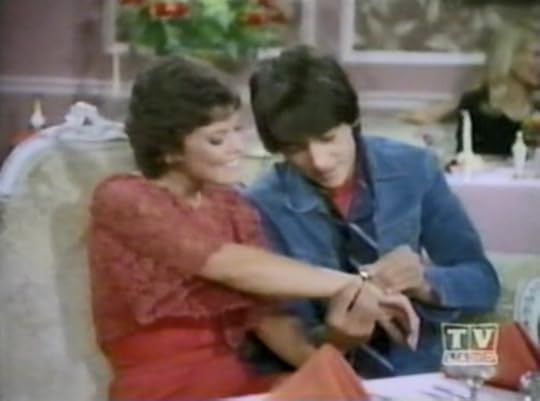 Erin Moran and Scott Baio on Happy Days.
Erin Moran and Scott Baio on Happy Days.As I wrote last week, Happy Days was in flux at the start of its ninth (and antepenultimate) season in 1981. With Richie (Ron Howard) and Ralph (Donny Most) long gone and cool guy Fonzie (Henry Winkler) becoming a grownup with responsibilities, the sitcom was in danger of losing touch with its roots. From the first season onward, Happy Days was mostly about high school-aged kids and their various triumphs and tragedies. It was a happy-go-lucky world of sock hops, malt shops, and double dates. How do you keep that going after nine seasons?
The obvious answer was to shift the show's focus to its younger characters, Joanie (Erin Moran) and Chachi (Scott Baio). Never mind that these two were already supposed to be college-bound high school seniors during Season 8. They were given a second senior year in Season 9. Anything to keep the high school setting. Naturally, Joanie and Chachi's budding, troubled romance became a major source of storylines. Younger viewers could tune in each week to see if J&C were breaking up or making up.
The problem is that Joanie and Chachi are a fundamentally bad couple. When Chachi joined the show in Season 5, he was a sleazy little schemer, always selling something or trying to con people out of a little money. He brought that dishonesty and insincerity to his relationship with Joanie. He's also a petulant and selfish little twerp, prone to temper tantrums. And Joanie, apparently lovestruck, forgives him for his many, many flaws. The relationship turns her into a weak character when she'd previously been the show's resident firebrand.
These issues are on full display in the episode we're reviewing this week, "Another Night at Antoine's." The plot has Chachi breaking up with Joanie so they can date other people for a while. Sort of a sexual Rumspringa. But then he decides he wants her back, and it all leads to a big, public kerfuffle at a fancy French restaurant. (No points for guessing that it ends with a reconciliation.)
So Joanie and Chachi are a bad couple, but does that make "Another Night at Antoine's" a bad episode? Find out by listening to the latest installment of These Days Are Ours: A Happy Days Podcast .
Published on September 27, 2022 14:50



